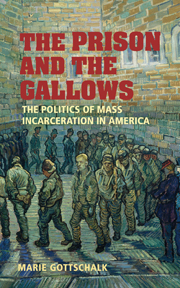The death penalty has cast a long, often dark shadow over the U.S. penal system and the politics of punishment. The contentious politics surrounding efforts to abolish and reinstate the death penalty in the United States in the twentieth century helped transform the broader politics associated with criminal justice and law enforcement. In an exceptional outcome, the political and judicial debate over capital punishment facilitated the construction of a vast penal system in the United States.
Over the past four decades, the United States has embarked on a prison-building boom without precedent here or elsewhere. The number of inmates increased dramatically, rising more than sixfold since the early 1970s. Today a higher proportion of the adult population is behind bars than anywhere else in the world. The U.S. incarceration rate of 754 per 100,000 is 5 to 12 times the rate of the Western European countries and Japan. About one of every one hundred adults in the United States is behind bars today, and one in thirty-one is under some form of state supervision, including jail, prison, parole, probation, and other sanctions.
The exceptional political and institutional trajectory of capital punishment is not the sole or even the primary explanation for the turn toward more punitive policies and mass incarceration in the United States. Rather, it is an important contributing factor alongside the social, political, racial, institutional, and economic factors identified by Garland, Beckett, Alexander, Wacquant, Simon, Tonry, and others.
